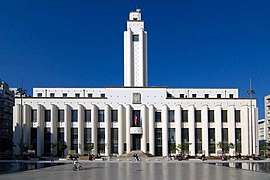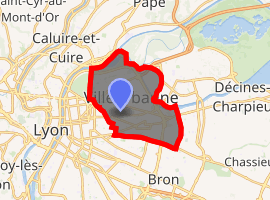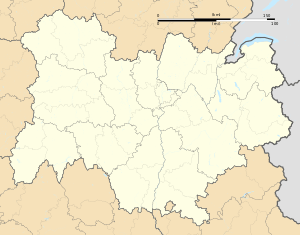Villeurbanne
Villeurbanne (French pronunciation: [vi.lœʁ.ban]; Arpitan: Velorbana) is a commune in the Metropolis of Lyon in Auvergne-Rhône-Alpes region in eastern France.
Villeurbanne | |
|---|---|
 The city hall | |
.svg.png) Coat of arms | |
Location of Villeurbanne 
| |
 Villeurbanne  Villeurbanne | |
| Coordinates: 45°46′00″N 4°52′49″E | |
| Country | France |
| Region | Auvergne-Rhône-Alpes |
| Metropolis | Metropolis of Lyon |
| Arrondissement | Lyon |
| Government | |
| • Mayor (2014–2020) | Jean-Paul Bret (PS) |
| Area 1 | 14.52 km2 (5.61 sq mi) |
| Population (2017-01-01)[1] | 147,712 |
| • Density | 10,000/km2 (26,000/sq mi) |
| Time zone | UTC+01:00 (CET) |
| • Summer (DST) | UTC+02:00 (CEST) |
| INSEE/Postal code | 69266 /69100 |
| Elevation | 165–189 m (541–620 ft) (avg. 181 m or 594 ft) |
| 1 French Land Register data, which excludes lakes, ponds, glaciers > 1 km2 (0.386 sq mi or 247 acres) and river estuaries. | |
It is situated northeast of Lyon, with which it forms the heart of the second-largest metropolitan area in France after that of Paris. Villeurbanne is the second-largest city in the metropolitan area of Lyon and the 20th most populated in France.[2] In 2013, Villeurbanne was elected the city with the best administration of France, which attracts more and more people.
History
The current location of downtown Villeurbanne is known to have been inhabited as far back as 6000 BC. Its current name comes from a Gallo-Roman farming area, established at about the same time as Lyon (then Lugdunum) and known as the Villa Urbana ("town house"). It would then become Urbanum, then Villa Urbane and, ultimately, Villeurbanne.
Villeurbanne has belonged to the kingdom of France since 1349. It was then separated from La Guillotière (A former city lately incorporated into Lyon as the 3rd, 6th, 7th and 8th Arrondissment) by the river La Rize, a former branch of the Rhône River.
Until the 19th century, the city was merely a patchwork of distinct villages separated by fields and undeveloped land. These villages have mostly survived, and nowadays form the neighborhoods of Charpennes, Cusset, Croix-Luizet, Maisons-Neuves, etc.
With the industrial era, Villeurbanne's economy soared: the textile industry was the first to bloom, followed by mechanical and chemical ones. The factories lured in numerous immigrants, most notably from Italy. Transforming from a rural community to an industrial town, Villeurbanne underwent a tremendous demographic boom in the late 1920s. From 3,000 inhabitants in 1928, its population rocketed to 82,000 in 1931. Mayor Lazare Goujon (elected 1924) engaged the city in a vast public works initiative. Arguably the most visible heritage of this program is the Gratte-Ciel, a housing complex made up of two Art Deco towers and annex smaller buildings, lining up along the Avenue Henri Barbusse. These structures are the work of architect Môrice Leroux, and one of the most notable Art Deco structures in France. Having undergone thorough renovation, the 19-story twin towers have become an emblem of the city.
 Grattes-ciel building, Villeurbanne
Grattes-ciel building, Villeurbanne Lazare Goujon Square and Villeurbanne Cityhall
Lazare Goujon Square and Villeurbanne Cityhall
Education
Primary and secondary schools
Public senior high schools:
- Lycée Faÿs[3]
- Lycée Alfred de Musset[4]
- Lycée Marie Curie Villeurbanne[5]
- Lycée Pierre Brossolette[6]
- Lycée Magenta[7]
Private schools:
Colleges and universities
Many colleges and universities of the Lyon metropolitan area are located in Villeurbanne. Many of these are located on the La Doua campus, home to the Claude Bernard University (Lyon I), a public university, CPE Lyon and the Institut National des Sciences Appliquées de Lyon, one of the premier engineering institute (Grandes écoles) in France, very well known for high quality education and for research in France.
Weekend schools
The Association Pour le Developpement de la Langue et de la Culture Japonaises (ADLCJ; リヨン補習授業校 Riyon Hoshū Jugyō Kō), a part-time Japanese supplementary school, is held in the Maison Berty Albrecht in Villeurbanne.[10] It was formed in 1987.[11]
Transport
Villeurbanne is well served by the Lyon area public transit system, the TCL (Transports en Commun Lyonnais). The east branch of subway line A runs through the city heart, and the new tramway lines T1 and T4 connects the La Doua campus to the Lyon business and commercial district of La Part-Dieu and the Presqu'île downtown.
International relations
Twin towns — sister cities
Villeurbanne is twinned with:
In addition, Villeurbanne has a friendship declaration with:
Demography
| Year | Pop. | ±% |
|---|---|---|
| 1793 | 1,617 | — |
| 1800 | 1,654 | +2.3% |
| 1806 | 1,834 | +10.9% |
| 1821 | 2,136 | +16.5% |
| 1831 | 2,826 | +32.3% |
| 1836 | 2,998 | +6.1% |
| 1841 | 3,677 | +22.6% |
| 1846 | 4,252 | +15.6% |
| 1851 | 5,395 | +26.9% |
| 1856 | 5,339 | −1.0% |
| 1861 | 5,850 | +9.6% |
| 1866 | 6,663 | +13.9% |
| 1872 | 7,474 | +12.2% |
| 1876 | 9,033 | +20.9% |
| 1881 | 11,176 | +23.7% |
| 1886 | 14,715 | +31.7% |
| 1891 | 17,940 | +21.9% |
| 1896 | 21,714 | +21.0% |
| 1901 | 29,220 | +34.6% |
| 1906 | 33,890 | +16.0% |
| 1911 | 42,526 | +25.5% |
| 1921 | 56,110 | +31.9% |
| 1926 | 63,775 | +13.7% |
| 1931 | 82,038 | +28.6% |
| 1936 | 81,322 | −0.9% |
| 1946 | 82,399 | +1.3% |
| 1954 | 81,769 | −0.8% |
| 1962 | 105,416 | +28.9% |
| 1968 | 119,879 | +13.7% |
| 1975 | 116,535 | −2.8% |
| 1982 | 115,960 | −0.5% |
| 1990 | 116,872 | +0.8% |
| 1999 | 124,215 | +6.3% |
| 2006 | 134,500 | +8.3% |
| 2007 | 138,151 | +2.7% |
| 2011 | 145,034 | +5.0% |
| 2012 | 146,282 | +0.9% |
| From 1962, the number here is the population without double counting Sources : Cassini-LDH of the EHESS[13] and Insee[14] | ||
In terms of number of inhabitants, the city of Villeurbanne is the second city of the Metropolis of Lyon, the fourth city of the region Rhône-Alpes, the 27th city of France.
Notable people
The list of notable native Villeurbannais includes:
- Mourad Benhamida, French footballer, 18 January 1986
- Henry Bertrand, silk weaver
- Xavier Chavalerin, midfielder, 7 March 1991
- Henri Cochet, French tennis player, 4 December 1901 (†1987)
- Willem Geubbels, footballer
- Charles Hernu, French politician, mayor of Villeurbanne (1977-1990)
- Florent Manaudou, French swimmer, 12 November 1990
- Laure Manaudou, French swimmer, world record holder, 9 October 1986
- Gnonsiane Niombla, handball player
- Jean-Karl Vernay, French race car driver, 31 October 1987
- José Vespasien, basketball player
- Amos Youga, footballer
See also
- Communes of the Metropolis of Lyon
References
- "Populations légales 2017". INSEE. Retrieved 6 January 2020.
- "Villes et communes de France − Tableaux de l'économie française | Insee". www.insee.fr. Retrieved 2019-08-28.
- Home. Lycée Faÿs. Retrieved on September 4, 2016.
- Home. Lycée Alfred de Musset. Retrieved on September 4, 2016.
- Home. Lycée Marie Curie Villeurbanne. Retrieved on September 4, 2016.
- Home. Lycée Pierre Brossolette. Retrieved on September 4, 2016.
- Home. Lycée Magenta. Retrieved on September 4, 2016.
- Home page. Institution Scolaire Immaculée Conception. Retrieved on September 4, 2016.
- Home page. Ecole Beth Menahem. Retrieved on September 4, 2016.
- "欧州の補習授業校一覧(平成25年4月15日現在)" (Archive). Ministry of Education, Culture, Sports, Science and Technology (MEXT). Retrieved on May 10, 2014. "Maison Berty Albrecht 14, Place Grandclement, 69100 Viueurbanne, FRANCE"
- Home page. Association Pour le Developpement de la Langue et de la Culture Japonaises. Retrieved on May 12, 2006.
- "Des villages de Cassini aux communes d'aujourd'hui" (in French). École des hautes études en sciences sociales. Retrieved 3 February 2012.
- "Recensement de la population au 1er janvier 2012" (in French). INSEE. Retrieved 3 February 2012.
- Notes
External links
| Wikimedia Commons has media related to Villeurbanne. |
- Official website (in French)
- Villeurbanne Message Board (in French)